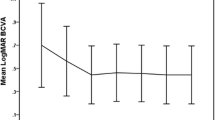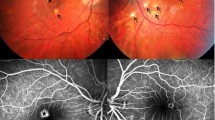Abstract
Purpose
This study aims to evaluate the outcomes of adalimumab (ADA) therapy in patients with refractory punctate inner choroidopathy (PIC) and multifocal choroiditis (MFC).
Methods
Demographic and clinical data, including LogMAR best-corrected visual acuity (BCVA), were retrospectively collected. Doses of prednisone, immunomodulatory therapies (IMT), and anti-vascular endothelial growth factor (VEGF) injections before and after baseline (ADA initiation) were recorded, as well as the time to clinical remission, time to first flare, and drug-associated adverse events.
Results
Seven patients (4 females, ten eyes) were included. The mean follow-up after baseline was 17.8 ± 11.1 months (range 6–33). The mean LogMAR BCVA was 0.35 ± 0.77 at 6 months before baseline and remained stable throughout 12 months after baseline (0.31 ± 0.46 at 12 months; p = 0.47). The mean dose of prednisone decreased from 17.3 ± 19.6 mg/day 6 months before baseline (range 0–60) to 2.6 ± 2.4 mg/day at the last follow-up (range 0–6, p = 0.03). The mean number of flares decreased significantly from 1.43 ± 0.79 over a 6-month period before baseline to 0.2 ± 0.45 (p = 0.02) at 6–12 months after baseline. The mean number of anti-VEGF injections was 4.17 ± 3.92 over the 12-month period before baseline, and it was 2.17 ± 3.06 (p = 0.31) during the first 12 months after baseline. No adalimumab-related adverse events were noted.
Conclusion
Adalimumab therapy for refractory PIC/MFC enabled a significant steroid-sparing effect, decreased disease flares, and preserved vision over a mean follow-up of 17.8 months.






Similar content being viewed by others
Data availability
The corresponding author has full access to all the data in the study and takes responsibility for the integrity of the data and the accuracy of the data analysis as well as the decision to submit for publication
Code availability
Not applicable.
References
Ahnood D, Madhusudhan S, Tsaloumas MD et al (2017) Punctate inner choroidopathy: a review. Surv Ophthalmol 62:113–126. https://doi.org/10.1016/j.survophthal.2016.10.003
Essex RW, Wong J, Fraser-Bell S et al (2010) Punctate inner choroidopathy: clinical features and outcomes. Arch Ophthalmol 128:982–987. https://doi.org/10.1001/archophthalmol.2010.157
Kedhar SR, Thorne JE, Wittenberg S et al (2007) Multifocal choroiditis with panuveitis and punctate inner choroidopathy: comparison of clinical characteristics at presentation. Retina 27:1174–1179. https://doi.org/10.1097/IAE.0b013e318068de72
Spaide RF, Goldberg N, Freund KB (2013) Redefining multifocal choroiditis and panuveitis and punctate inner choroidopathy through multimodal imaging. Retina 33:1315–1324. https://doi.org/10.1097/IAE.0b013e318286cc77
Dreyer RF, Gass DJ (1984) Multifocal choroiditis and panuveitis. A syndrome that mimics ocular histoplasmosis. Arch Ophthalmol 102:1776–1784
Joondeph BC, Tessler HH (1990) Multifocal choroiditis. Int Ophthalmol Clin 30:286–290
Watzke RC, Packer AJ, Folk JC et al (1984) Punctate inner choroidopathy. Am J Ophthalmol 98:572–584. https://doi.org/10.1016/0002-9394(84)90243-5
Amer R, Lois N (2011) Punctate inner choroidopathy. Surv Ophthalmol 56:36–53. https://doi.org/10.1016/j.survophthal.2010.03.009
Gerstenblith AT, Thorne JE, Sobrin L et al (2007) Punctate inner choroidopathy. A survey analysis of 77 persons. Ophthalmology 114:1201–1204. https://doi.org/10.1016/j.ophtha.2006.10.047
Galor A, Jabs DA, Leder HA et al (2008) Comparison of antimetabolite drugs as corticosteroid-sparing therapy for noninfectious ocular inflammation. Ophthalmology 115:1826–1832. https://doi.org/10.1016/j.ophtha.2008.04.026
de Groot EL, ten Dam-van Loon NH, de Boer JH, Ossewaarde-van Norel J (2020) The efficacy of corticosteroid-sparing immunomodulatory therapy in treating patients with central multifocal choroiditis. Acta Ophthalmol 98:816–821. https://doi.org/10.1111/aos.14473
Brown JJ, Folk JC, Reddy CV, Kimura AE (1996) Visual prognosis of multifocal choroiditis, punctate inner choroidopathy, and the diffuse subretinal fibrosis syndrome. Ophthalmology 103:1100–1105. https://doi.org/10.1016/s0161-6420(96)30561-7
Mansour AM, Arevalo JF, Ziemssen F et al (2009) Long-term visual outcomes of intravitreal bevacizumab in inflammatory ocular neovascularization. Am J Ophthalmol 148:310–316. https://doi.org/10.1016/j.ajo.2009.03.023
Dolz-Marco R, Gallego-Pinazo R, Díaz-Llopis M et al (2015) Noninfectious uveitis: strategies to optimize treatment compliance and adherence. Clin Ophthalmol 9:1477. https://doi.org/10.2147/OPTH.S36650
Jaffe GJ, Dick AD, Brézin AP et al (2016) Adalimumab in patients with active noninfectious uveitis. N Engl J Med. https://doi.org/10.1056/NEJMoa1509852
Nguyen QD, Merrill PT, Jaffe GJ et al (2016) Adalimumab for prevention of uveitic flare in patients with inactive non-infectious uveitis controlled by corticosteroids (VISUAL II): a multicentre, double-masked, randomised, placebo-controlled phase 3 trial. Lancet 388:1183–1192. https://doi.org/10.1016/S0140-6736(16)31339-3
de Groot EL, Ossewaarde-van Norel J, Ho L et al (2020) The efficacy of adalimumab in treating patients with central multifocal choroiditis. Am J Ophthalmol Case Rep 20:100921. https://doi.org/10.1016/j.ajoc.2020.100921
Brueggeman RM, Noffke AS, Jampol LM (2002) Resolution of punctate inner choroidopathy lesions with oral prednisone therapy. Arch Ophthalmol 120:996. https://doi.org/10.1001/archopht.120.7.996
Levy J, Shneck M, Klemperer I, Lifshitz T (2005) Punctate inner choroidopathy: resolution after oral steroid treatment and review of the literature. Can J Ophthalmol 40:605–608. https://doi.org/10.1016/S0008-4182(05)80053-5
Matsuda S, Gomi F, Oshima Y et al (2005) Vascular endothelial growth factor reduced and connective tissue growth factor induced by triamcinolone in ARFE19 cells under oxidative stress. Investig Ophthalmol Vis Sci 46:1062–1068. https://doi.org/10.1167/iovs.04-0761
Flaxel CJ, Owens SL, Mulholland B et al (1998) The use of corticosteroids for choroidal neovascularisation in young patients. Eye 12:266–272. https://doi.org/10.1038/eye.1998.62
Wu W, Li S, Xu H et al (2018) Treatment of punctate inner choroidopathy with choroidal neovascularization using corticosteroid and intravitreal ranibizumab. Biomed Res Int 2018:1585803. https://doi.org/10.1155/2018/1585803
Niederer RL, Gilbert R, Lightman SL, Tomkins-Netzer O (2018) Risk factors for developing choroidal neovascular membrane and visual loss in punctate inner choroidopathy. Ophthalmology 125:288–294. https://doi.org/10.1016/j.ophtha.2017.09.002
Neri P, Pichi F, Pirani V, Arapi I (2020) Systemic immunosuppression is highly effective in the long-term control of inflammatory non-infectious uveitic choroidal neovascularization: a comparative study. Ocul Immunol Inflamm 1–5. https://doi.org/10.1080/09273948.2020.1727530
Ambati J, Atkinson JP, Gelfand BD (2013) Immunology of age-related macular degeneration. Nat Rev Immunol 13:438–451. https://doi.org/10.1038/nri3459
Seregard S, Algvere PV, Berglin L (1994) Immunohistochemical characterization of surgically removed subfoveal fibrovascular membranes. Graefes Arch Clin Exp Ophthalmol 232:325–329. https://doi.org/10.1007/BF00175983
Sakurai E, Anand A, Ambati BK et al (2003) Macrophage depletion inhibits experimental choroidal neovascularization. Investig Ophthalmol Vis Sci 44:3578–3585. https://doi.org/10.1167/iovs.03-0097
Cherepanoff S, McMenamin P, Gillies MC et al (2010) Bruch’s membrane and choroidal macrophages in early and advanced age-related macular degeneration. Br J Ophthalmol 94:918–925. https://doi.org/10.1136/bjo.2009.165563
Cao X, Shen D, Patel MM et al (2011) Macrophage polarization in the maculae of age-related macular degeneration: a pilot study. Pathol Int 61:528–535. https://doi.org/10.1111/j.1440-1827.2011.02695.x
Kelly J, Khan AA, Yin J et al (2007) Senescence regulates macrophage activation and angiogenic fate at sites of tissue injury in mice. J Clin Invest 117:3421–3426. https://doi.org/10.1172/JCI32430
Lederman M, Weiss A, Chowers I (2010) Association of neovascular age-related macular degeneration with specific gene expression patterns in peripheral white blood cells. Investig Ophthalmol Vis Sci 51:53–58. https://doi.org/10.1167/iovs.08-3019
Author information
Authors and Affiliations
Contributions
Conceptualization, RA; methodology, OS and RA; formal analysis and investigation, OS; writing — original draft preparation, OS; writing — review and editing, OS and RA; supervision, RA.
Corresponding author
Ethics declarations
Ethics approval and consent to participate
All procedures performed in studies involving human participants were in accordance with the ethical standards of the institutional (HMO-Hadassah Medical Organization IRB approved the study) and/or national research committee and with the 1964 Helsinki Declaration and its later amendments or comparable ethical standards.
Consent for publication
Not applicable. The study does not contain any patient identifying information.
Conflict of interest
Shmueli, none; Amer, Abbvie lecturer.
Additional information
Publisher’s note
Springer Nature remains neutral with regard to jurisdictional claims in published maps and institutional affiliations.
Rights and permissions
About this article
Cite this article
Shmueli, O., Amer, R. Outcomes of adalimumab therapy in refractory punctate inner choroidopathy and multifocal choroiditis. Graefes Arch Clin Exp Ophthalmol 260, 2013–2021 (2022). https://doi.org/10.1007/s00417-021-05539-9
Received:
Revised:
Accepted:
Published:
Issue Date:
DOI: https://doi.org/10.1007/s00417-021-05539-9




